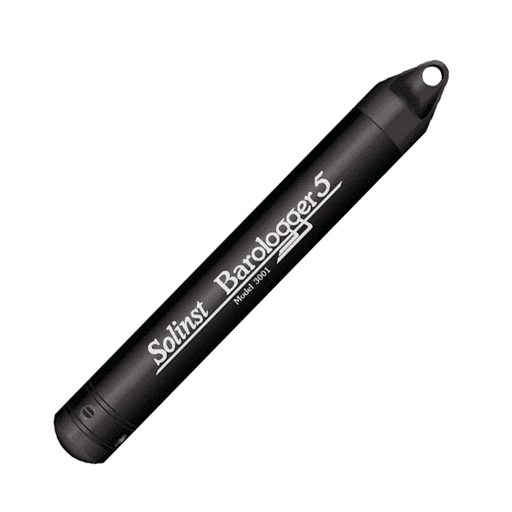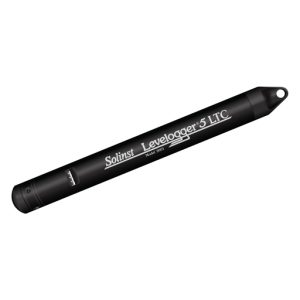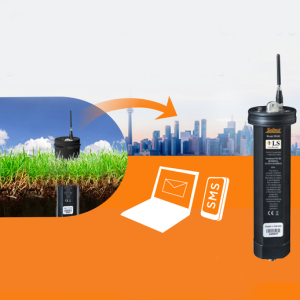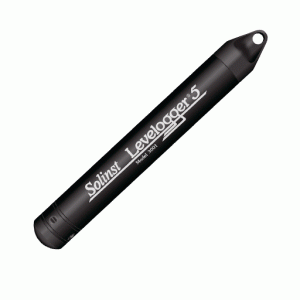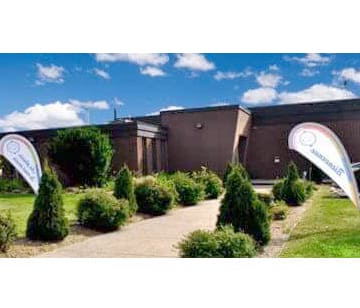Leveloggers measure absolute pressure (water pressure + atmospheric pressure) expressed in feet, meters, centimeters, psi, kPa, or mbar. The Barologger 5 uses algorithms based on air pressure only.
Ideal for:
- Pump and slug tests
- Reservoir and stormwater runoff management
- Watershed and drainage basin monitoring
- Stream gauging, lake, and wetland monitoring
- Tank level measurement
- Monitoring water levels in wells and surface water
Note:
The Barologger should not be used to monitor water, as the internal mathematics for temperature compensation are based on air rather than water.
The Barologger 5 uses the most accurate method of monitoring water level, by measuring changes in atmospheric pressure / temperature, which are used to compensate the recorded water level readings. The air agorithms are more accurate then water pressure, resulting in superior accuracy.
Set above the high water level in one location on site, one Barologger can compensate all Leveloggers in a 30 km (20 miles) radius and/or within every 300 m (1000 ft.) change in elevation.
The Levelogger Software Data Compensation Wizard automatically produces compensated data files using the synchronized data files from the Barologger and Leveloggers on site.
The recorded barometric information can be used to determine the barometric lag and/or barometric efficiency of the monitored aquifer.
When compensating submerged Levelogger 5, Edge, Gold, or Junior data, Levelogger Software can recognize the type of Levelogger and compensate using the same units found in the submerged data file (e.g. feet or meters). This makes the Barologger 5 backward compatible.
Why Use a Barologger?
While Leveloggers measure total pressure (water column equivalent + barometric pressure), in order to accurately determine changes in water level, barometric pressure fluctuations must be removed from the data. The best way to do this is by suspending Barologger above the water level in a well. The approx. site compensation is 20 miles (30 km). Recording ambient barometric fluctuations over time allows quick and accurate barometric compensation using the data files from both the Barologger and any Leveloggers in the area.

Manual Barometric Compensation from a local weather station
If an on-site Barologger is not available, the data can be compensated with alternate barometric data (e.g. from a local weather station).
To accomplish this, the weather station should be within 20 miles (30 km) area, and within an elevation range of 1000 ft (300 m). The date and time should correspond to the range of data collected by the Levelogger.
Your Levelogger data and barometric data use in the same units and make sure the normalization values are accounted for. Previous Levelogger and Barologger models (e.g. Gold) produce data with an offset of 31.17 ft or 9.5 m (lowest expected pressure at mean sea level) removed from the level values. Levelogger Edge data does not have this offset. The weather station barometric data will often contain a different offset or normalization. Manual data conversion and barometric compensation should account for any variation between the barometric data sourced and Solinst Leveloggers.
| Pressure Conversion Factors | ||
|---|---|---|
| Barometric Unit | FOOT Water Column Equivalent | METER Water Column Equivalent |
| 1 psi | 2.30666 | 0.703070 |
| 1 kPa | 0.334553 | 0.101972 |
| 1 mbar | 0.0334553 | 0.0101972 |
Examples:
1.Conversion from psi to feet of water column equivalent: Example: 15 psi (for Levelogger Edge):
15 psi x 2.30666 ft/psi = 34.60 ft head
2.Conversion from kPa to meters of water column equivalent: Example: 101.40 kPa (for older Levelogger):
101.4 kPa x 0.101972 m/kPa = 10.34 m – 9.50 m offset = 0.84 m head
* Values in green denote pressure conversion factors; consult the table above to obtain common pressure conversions
Once the final calculated barometric pressure values are obtained, they are subtracted from the Levelogger data set. Since the Levelogger data can be easily exported as a .csv or .xml file using Levelogger Software, all manual corrections can be performed in external programs.
In an example where the uncompensated Levelogger Edge data is a water level of 41.17 ft, from the calculation above, the manual compensation would be: 41.17 ft – 34.60 = 6.57 ft.
In an example where the uncompensated older Levelogger data is a water level of 3 m, from the calculation above, the manual compensation would be: 3 m – 0.84 = 2.16 m.
Barologger Installation
The Barologger is a Levelogger with a small range adequate to monitor the fluctuations that occur in barometric pressure. The Barologger’s readings are used to barometrically compensate Levelogger readings. As a rule of thumb, a Barologger can be used to compensate all the Leveloggers in a 30 km (20 mile) radius and/or with every 300 m (1000 ft) change in elevation.
To monitor barometric pressure correctly, the Barologger should never be submerged. In well installations, it is recommended that the Barologger be suspended in one of the monitored wells above the high water point (the well must be vented). For best reading accuracy, the Barologger should be installed in a similar thermal environment to that of the Levelogger. In groundwater wells, the Barologger should be suspended beyond the frost line and deep enough to avoid large temperature fluctuations. In surface water applications, the Barologger is best deployed in a dry well – a well embedded in the bottom of the water body, but sealed at the base from water entry and vented to the atmosphere. If a dry well cannot be installed, the Barologger can be installed on a float in the stilling well.
| Barologger 5 Technical Specifications | |
|---|---|
| Level Sensor: | Piezoresistive Silicon with Hastelloy Sensor |
| Accuracy: | ± 0.05 kPa |
| Resolution: | 0.002% FS |
| Normalization: | Automatic Temperature Compensation |
| Temp. Comp. Range: | -10ºC to 50ºC |
| Temperature Sensor: | Platinum Resistance Temperature Detector (RTD) |
| Temp. Sensor Accuracy: | ± 0.05ºC |
| Temp. Sensor Resolution: | 0.003ºC |
| Battery Life: | 10 years (based on 1 reading/minute) |
| Clock Accuracy (typical): | ±1 minute/year (-20ºC to 80ºC) |
| Operating Temperature: | -20ºC to 80ºC |
| Maximum # Readings: | 150,000 sets of readings |
| Memory: | Continuous or Slate mode |
| Communication Speed: | 9600 bps, 57,600 bps with USB |
| Com Interface: | Optical high-speed: USB, SDI-12 |
| Size: | 22 mm x 160 mm (7/8″ x 6.3″ ) |
| Weight: | 166 grams (5.9 oz.) |
| Corrosion Resistance: | Baked-on coating using polymerization technology (inside and out) and superior corrosion resistant Hastelloy pressure sensor |
| Other Wetted Materials: | Delrin®, Viton®, 316L Stainless Steel |
| Sampling Modes: | Linear, Event & User-Selectable Schedule with Repeat Mode, Future Start, Future Stop, Real Time View |
| Measurement Rates: | 0.125 second to 99 hours |
| Model | Full Scale (FS) | Accuracy | Resolution |
|---|---|---|---|
| Barologger | Air Only | ±0.05 kPa | 0.002% FS |
Leveloggers measure absolute pressure (water pressure + atmospheric pressure) expressed in feet, meters, centimeters, psi, kPa, or mbar. The Barologger 5 uses algorithms based on air pressure only.
Ideal for:
- Pump and slug tests
- Reservoir and stormwater runoff management
- Watershed and drainage basin monitoring
- Stream gauging, lake, and wetland monitoring
- Tank level measurement
- Monitoring water levels in wells and surface water
Note:
The Barologger should not be used to monitor water, as the internal mathematics for temperature compensation are based on air rather than water.
The Barologger 5 uses the most accurate method of monitoring water level, by measuring changes in atmospheric pressure / temperature, which are used to compensate the recorded water level readings. The air agorithms are more accurate then water pressure, resulting in superior accuracy.
Set above the high water level in one location on site, one Barologger can compensate all Leveloggers in a 30 km (20 miles) radius and/or within every 300 m (1000 ft.) change in elevation.
The Levelogger Software Data Compensation Wizard automatically produces compensated data files using the synchronized data files from the Barologger and Leveloggers on site.
The recorded barometric information can be used to determine the barometric lag and/or barometric efficiency of the monitored aquifer.
When compensating submerged Levelogger 5, Edge, Gold, or Junior data, Levelogger Software can recognize the type of Levelogger and compensate using the same units found in the submerged data file (e.g. feet or meters). This makes the Barologger 5 backward compatible.
Why Use a Barologger?
While Leveloggers measure total pressure (water column equivalent + barometric pressure), in order to accurately determine changes in water level, barometric pressure fluctuations must be removed from the data. The best way to do this is by suspending Barologger above the water level in a well. The approx. site compensation is 20 miles (30 km). Recording ambient barometric fluctuations over time allows quick and accurate barometric compensation using the data files from both the Barologger and any Leveloggers in the area.

Manual Barometric Compensation from a local weather station
If an on-site Barologger is not available, the data can be compensated with alternate barometric data (e.g. from a local weather station).
To accomplish this, the weather station should be within 20 miles (30 km) area, and within an elevation range of 1000 ft (300 m). The date and time should correspond to the range of data collected by the Levelogger.
Your Levelogger data and barometric data use in the same units and make sure the normalization values are accounted for. Previous Levelogger and Barologger models (e.g. Gold) produce data with an offset of 31.17 ft or 9.5 m (lowest expected pressure at mean sea level) removed from the level values. Levelogger Edge data does not have this offset. The weather station barometric data will often contain a different offset or normalization. Manual data conversion and barometric compensation should account for any variation between the barometric data sourced and Solinst Leveloggers.
| Pressure Conversion Factors | ||
|---|---|---|
| Barometric Unit | FOOT Water Column Equivalent | METER Water Column Equivalent |
| 1 psi | 2.30666 | 0.703070 |
| 1 kPa | 0.334553 | 0.101972 |
| 1 mbar | 0.0334553 | 0.0101972 |
Examples:
1.Conversion from psi to feet of water column equivalent: Example: 15 psi (for Levelogger Edge):
15 psi x 2.30666 ft/psi = 34.60 ft head
2.Conversion from kPa to meters of water column equivalent: Example: 101.40 kPa (for older Levelogger):
101.4 kPa x 0.101972 m/kPa = 10.34 m – 9.50 m offset = 0.84 m head
* Values in green denote pressure conversion factors; consult the table above to obtain common pressure conversions
Once the final calculated barometric pressure values are obtained, they are subtracted from the Levelogger data set. Since the Levelogger data can be easily exported as a .csv or .xml file using Levelogger Software, all manual corrections can be performed in external programs.
In an example where the uncompensated Levelogger Edge data is a water level of 41.17 ft, from the calculation above, the manual compensation would be: 41.17 ft – 34.60 = 6.57 ft.
In an example where the uncompensated older Levelogger data is a water level of 3 m, from the calculation above, the manual compensation would be: 3 m – 0.84 = 2.16 m.
Barologger Installation
The Barologger is a Levelogger with a small range adequate to monitor the fluctuations that occur in barometric pressure. The Barologger’s readings are used to barometrically compensate Levelogger readings. As a rule of thumb, a Barologger can be used to compensate all the Leveloggers in a 30 km (20 mile) radius and/or with every 300 m (1000 ft) change in elevation.
To monitor barometric pressure correctly, the Barologger should never be submerged. In well installations, it is recommended that the Barologger be suspended in one of the monitored wells above the high water point (the well must be vented). For best reading accuracy, the Barologger should be installed in a similar thermal environment to that of the Levelogger. In groundwater wells, the Barologger should be suspended beyond the frost line and deep enough to avoid large temperature fluctuations. In surface water applications, the Barologger is best deployed in a dry well – a well embedded in the bottom of the water body, but sealed at the base from water entry and vented to the atmosphere. If a dry well cannot be installed, the Barologger can be installed on a float in the stilling well.
| Barologger 5 Technical Specifications | |
|---|---|
| Level Sensor: | Piezoresistive Silicon with Hastelloy Sensor |
| Accuracy: | ± 0.05 kPa |
| Resolution: | 0.002% FS |
| Normalization: | Automatic Temperature Compensation |
| Temp. Comp. Range: | -10ºC to 50ºC |
| Temperature Sensor: | Platinum Resistance Temperature Detector (RTD) |
| Temp. Sensor Accuracy: | ± 0.05ºC |
| Temp. Sensor Resolution: | 0.003ºC |
| Battery Life: | 10 years (based on 1 reading/minute) |
| Clock Accuracy (typical): | ±1 minute/year (-20ºC to 80ºC) |
| Operating Temperature: | -20ºC to 80ºC |
| Maximum # Readings: | 150,000 sets of readings |
| Memory: | Continuous or Slate mode |
| Communication Speed: | 9600 bps, 57,600 bps with USB |
| Com Interface: | Optical high-speed: USB, SDI-12 |
| Size: | 22 mm x 160 mm (7/8″ x 6.3″ ) |
| Weight: | 166 grams (5.9 oz.) |
| Corrosion Resistance: | Baked-on coating using polymerization technology (inside and out) and superior corrosion resistant Hastelloy pressure sensor |
| Other Wetted Materials: | Delrin®, Viton®, 316L Stainless Steel |
| Sampling Modes: | Linear, Event & User-Selectable Schedule with Repeat Mode, Future Start, Future Stop, Real Time View |
| Measurement Rates: | 0.125 second to 99 hours |
| Model | Full Scale (FS) | Accuracy | Resolution |
|---|---|---|---|
| Barologger | Air Only | ±0.05 kPa | 0.002% FS |






